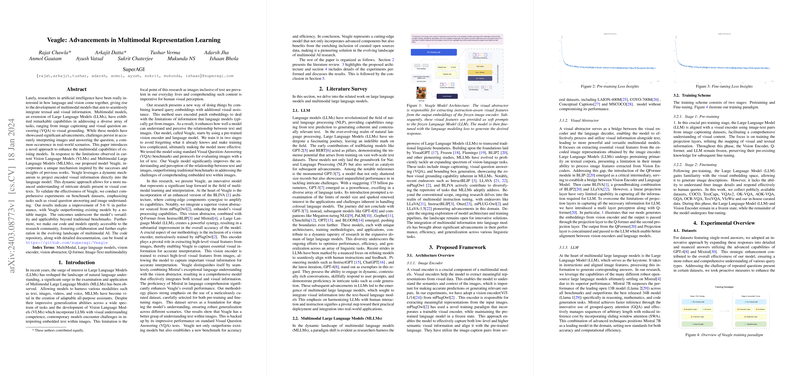Advancements in Multimodal Representation Learning through Veagle
The paper under consideration presents an innovative exploration into the domain of multimodal representation learning with the introduction of Veagle, a novel Vision-LLM (VLM) aimed at enhancing the capabilities of existing Multimodal LLMs (MLLMs). This paper is noteworthy in the landscape of multimodal AI, focusing on addressing the limitations observed in the interpretation of images with embedded text, a prevalent challenge in real-world scenarios.
The core of Veagle’s innovation lies in its integration of a dynamic mechanism that projects encoded visual information directly into the LLM. This sophisticated design is inspired by preceding successful models, notably emphasizing the role of a vision abstractor and leveraging a dynamic mechanism for nuanced comprehension. Such an approach enriches the model's understanding of intricate details within visual contexts, setting it apart from other models focused on text and image integration.
To empirically validate Veagle's efficacy, the authors conducted extensive experiments using benchmark datasets, with a particular focus on tasks such as Visual Question Answering (VQA) and image understanding. The results unveiled by these experiments highlight a performance enhancement of 5-6% over existing state-of-the-art models, with Veagle demonstrating superior versatility and applicability beyond conventional benchmarks. This improvement underscores its potential effectiveness and adaptability in diverse AI applications, confirming Veagle's capability to surpass traditional visual-text interpretation models.
The architecture of Veagle draws upon several cutting-edge components, including an advanced vision abstractor sourced from mPlugOwl and a Q-Former from InstructBLIP, which are combined with Mistral, a robust LLM. This synthesis of technologies creates a powerful engine that improves the accuracy and efficiency of multimodal interpretation tasks. Furthermore, the incorporation of a Vision Encoder enhances the extraction of high-level visual features, a feature crucial for detailed and accurate visual content interpretation.
The training methodology adopted for Veagle is methodologically sound, encompassing a two-stage process of pre-training and fine-tuning, leveraging curated datasets to ensure the model's comprehensive exposure to a broad spectrum of visual and contextual scenarios. The emphasis on both robust pre-training and meticulous fine-tuning is a testament to the thoroughness of the approach, facilitating effective knowledge retention and reducing training complexity.
The open-accessibility of Veagle's code further amplifies its contribution to the research community, promoting collaborative advancements and exploration in the field of multimodal AI. The availability of the code at the GitHub repository is a significant gesture towards fostering transparency and reproducibility in AI research.
In conclusion, Veagle represents a significant step forward in the integration of visual and textual modalities, enriching the potential for versatile, real-world AI applications. Its contribution to the theoretical understanding of multimodal representation learning is palpable, setting a new benchmark for future research endeavors. While the challenges in multimodal interpretation persist, the innovations and improvements introduced by Veagle offer a promising trajectory for overcoming these hurdles. As the landscape of multimodal AI continues to evolve, Veagle's enhancements provide a foundation for future developments that may further refine the integration of language and vision, potentially opening new avenues for exploration and application in the field of artificial intelligence.
